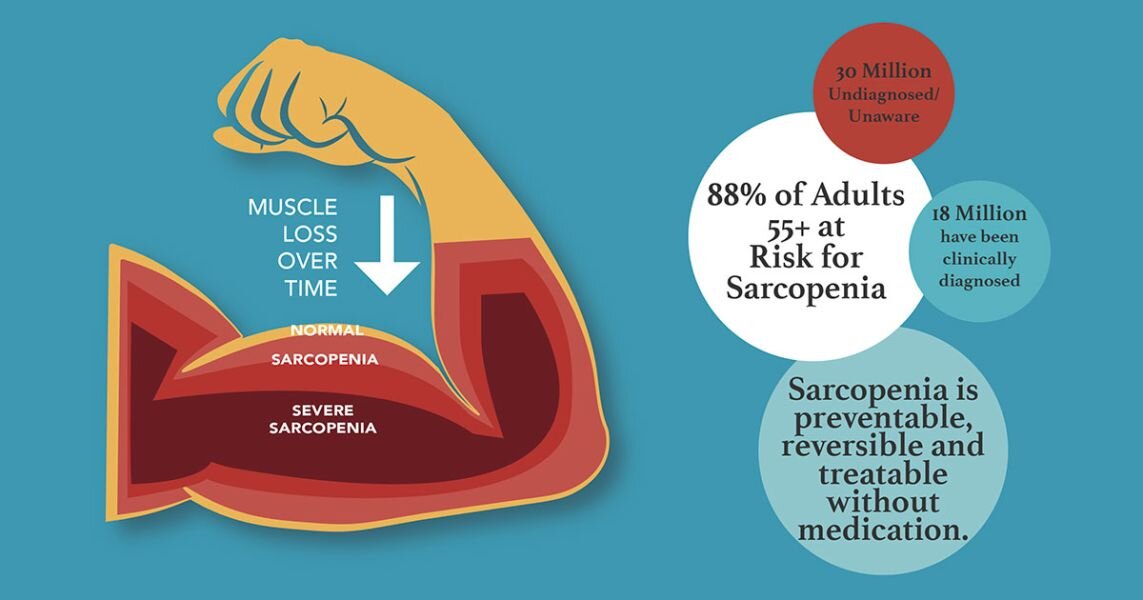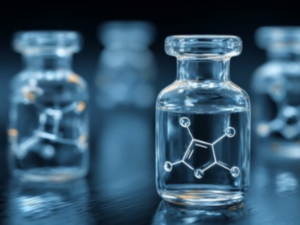Aging is a natural process that happens every second of the day. However, this does not mean that one cannot have a healthy body once they age. In this day and age, due to the great advances in the field of science and technology, it has become possible to not just slow the process of aging but also repair the damage caused by it. So much so, that the average life expectancy has increased with improved quality of life for people all around the world. We will discuss how Human Growth Hormone (HGH) and Testosterone play an important role in treating sarcopenia and prolonging healthy aging.
What is sarcopenia? How is it related to aging?
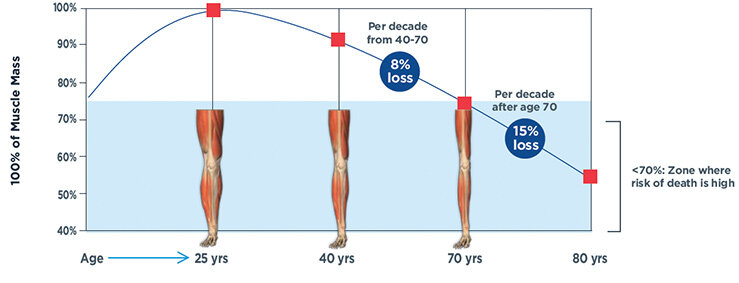
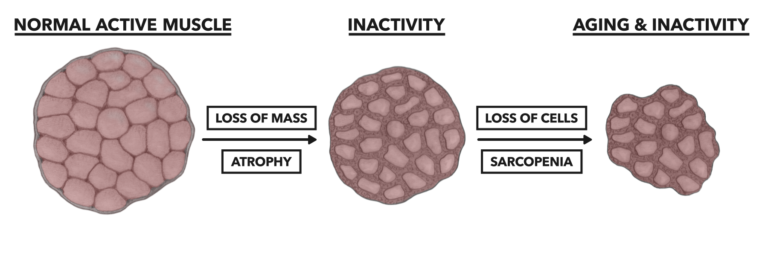
Sarcopenia is a syndrome that is most commonly seen in the geriatric population and hence is closely related to the age of the individual. The main manifestation of this disease is the loss of muscle mass and strength. This functional muscle loss weighs heavily on old patients, there are a lot more complications that can arise from this single disease. This syndrome significantly affects the quality of life of the individual suffering from it, as this disability makes it hard for the person to move around or do anything on their own.
It is due to the many damaging processes that happen in the body of those suffering from it. It has been seen that sarcopenia is multifactorial in nature and can happen due to either of the following reasons;
- Increase in proinflammatory cytokines.
- A decrease in hormonal levels, especially those hormones that are responsible for growth as well as normal metabolic processes of the body.
- It is also linked with decreased physical activity.
This explains why most people who suffer from sarcopenia belong to the old age group since most of the protective functions of the body deteriorate as cells age. The body’s normal repairing functions get slowed down, which eventually results in this condition.
A great decrease in levels of IGF-1 is seen in these patients. This marker is a general indicator of health and its low levels denote the excessive wear and tear happening in the body.
How does human growth hormone help patients with sarcopenia?
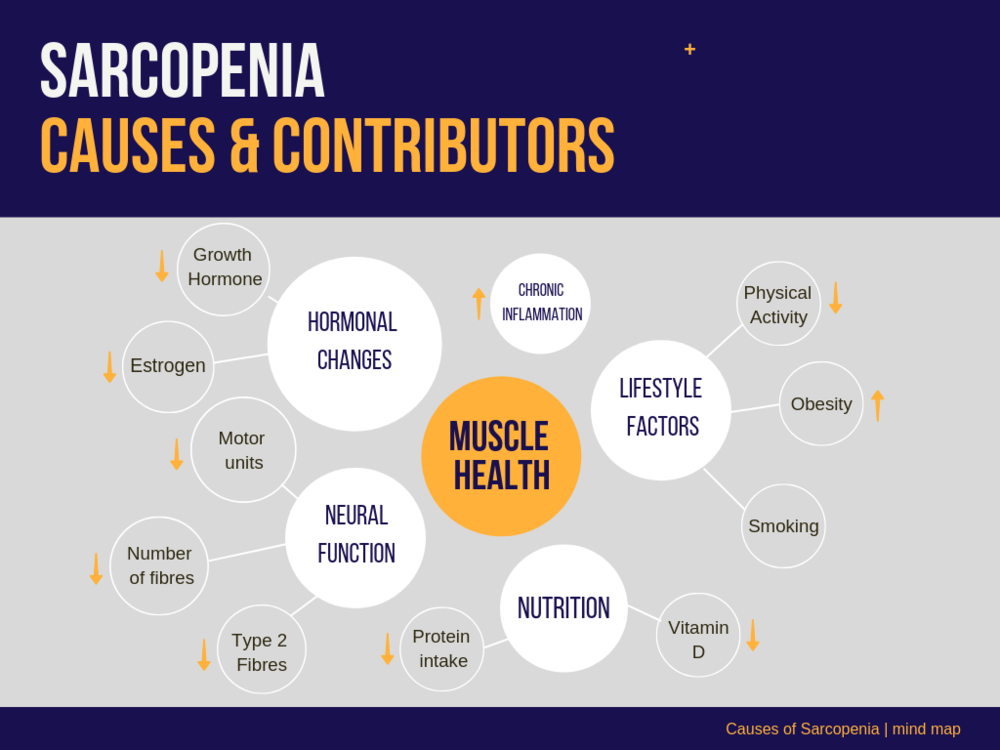
Sarcopenia is a syndrome characterized by loss of muscle strength and mass, that can very well be related to the deficiency of growth hormone in the body.
The Human Growth Hormone (HGH) is naturally produced in the body to help build muscle mass and let the body grow. The decreased levels of HGH directly influence many metabolic processes and affect activities of daily living such as walking, running, getting up, dressing, bathing, etc.
People of old age are the ones who experience a decrease in their levels of HGH as a normal process of aging, but it can very well be reversed if supplements of the HGH are given to such individuals. It has also been observed that growth hormone plays a vital role in decreasing oxidative damage to skeletal muscles.
The exact way that HGH works in repairing as well as delaying the onset of sarcopenia, is by activating the molecule of IGF-1. This molecule is widely known for its proliferative effects on the stem cells of skeletal muscle. This effective treatment goes a long way for patients of sarcopenia. It helps give strength to their muscles, decreases sarcopenic fat (excess fat accumulation due to sarcopenia) as well as increases muscle mass.
Some of the synthetically prepared growth hormones are discussed along with their clinical features as well as similarities in function;
- Norditropin – This human growth hormone supplement contains somatropin, which directly works by increasing the uptake of amino acids and proteins. This helps activate the myoblasts, helping replenish or build muscle mass. This drug is mostly given to children or adults with low or no natural human growth hormone. This drug is administered both intravenously and through subcutaneous routes. The IV infusion half-life is 21 minutes whereas the subcutaneous half-life is 7-10 hours.
- Omnitrope – It also contains somatropin as its active ingredient. However, it is a hormone supplement processed from the DNA molecule of E. coli. This recombinant structured drug is made by the modification of the human growth hormone gene with that of E. coli. This drug is injected subcutaneously and works as a growth hormone analog. The half-life of this drug is seen to be 2.5 to 2.8 hours. This indicates that omnitrope once administered stays in the system for a lot less time when compared with norditropin when given subcutaneously due to the difference in their half-lives.
- Saizen – This drug is similar to omnitrope as it is also prepared by recombinant DNA technology. The gene from a mammal (mouse) is modified by adding the normal gene of the human growth hormone. The structure of this drug is quite similar to that of the normal pituitary growth hormone. It is recommended for both the young and the old, who suffer from the deficiency of growth hormone. This drug can be administered in the body by both IV and subcutaneous routes. The bioavailability of this drug is 70-90%, indicating that both the routes are almost equally effective with a difference of 10-30%. The IV infusion has a half-life of 0.6 hours, whereas the subcutaneously injected drug has a half-life of 2 hours. This indicates that Saizen is very quickly washed out of the system and comparatively takes longer to reach the same effect, as seen with norditropin and omnitrope.
- Serostim – This growth hormone supplement is also prepared as a result of recombinant DNA technology. It uses the mammalian cell (mouse) modified with the gene of the human growth hormone. However, this particular drug is different from omnitrope as it is most commonly used in patients of HIV suffering from muscle wasting and cachexia. This drug is injected subcutaneously and comes in a lyophilized powder. The bioavailability of the subcutaneous infusion is exactly the same as Saizen; 70-90%. However, this is the drug that is mainly eliminated by the kidneys. Therefore, anyone with renal impairment, should not be given Serostim for their growth hormone deficiency. The half-life of this drug, when given through the subcutaneous route, is 4.28 hours, whereas that of an IV infusion is 0.58 hours.
- Genotropin – This drug is prepared using E.coli, by incorporating the human growth hormone gene into the organism’s genetic machinery to let it produce normal amounts of human growth hormone in the body. This drug is similar to omnitrope but it is more widely used in helping reverse hypopituitarism, Turner syndrome as well as pediatric growth hormone deficiency. The bioavailability of the subcutaneous infusion is seen to be 80%. It has been noted that the half-life of this drug is 3 hours. This makes the subcutaneous infusion of Genotropin stay in the body for a lot less time as compared to Norditropin and Serostim but sufficiently longer than Siazen and Omnitrope. This makes it more efficacious than the two.
- Zomacton – This drug also fights the deficiency of growth hormone in the body of both adults and children. Its chemical structure is identical to omnitrope and is prepared through recombinant DNA technology. However, some of its side-effects include gynecomastia (in males), as well as pancreatitis which is not seen with the administration of omnitrope. Zomacton is used both through IV and subcutaneous infusions. The bioavailability of this drug is 70%, which is slightly less than that of Genotropin. The half-life of this drug (IV) is seen to be 0.42 hours, whereas the half-life of the subcutaneous infusion is seen to be 2.3 hours. This denotes that Zomacton (IV administered) is cleared approximately 4 times faster than Norditropin. Zomacton is able to exert its effects for a longer time as compared to Saizen.
Work of testosterone in helping alleviate symptoms of sarcopenia

Testosterone is also one of the hormones that promote the building of muscle mass. It strengthens the fibers of skeletal muscles and prevents the development of sarcopenia. However, a significant decrease in the normal levels of testosterone occurs after the age of thirty in men.
The effect that testosterone has on men, is somewhat achieved in females by the release of androgens (which has similar effects as testosterone). However, the production of androgens also ceases with time making women more susceptible to sarcopenia than men.
This directly associates Testosterone Replacement Therapy (TRT) as one of the key factors to prevent sarcopenia in both men and women.
Sarcopenia is a condition that can very easily be avoided and treated if diagnosed early. Prevention and early detection of this debilitating illness is the key. In order to make sure your hormonal levels are in check, make sure to book your appointment with our physician at Alpha Hormones®.
References
- Santilli V, Bernetti A, Mangone M, Paoloni M. Clinical definition of sarcopenia. Clinical cases in mineral and bone metabolism. 2014 Sep;11(3):177.
- Morley JE. Hormones and sarcopenia. Current pharmaceutical design. 2017 Aug 1;23(30):4484-92.
- Brioche T, Kireev RA, Cuesta S, Gratas-Delamarche A, Tresguerres JA, Gomez-Cabrera MC, Vina J. Growth hormone replacement therapy prevents sarcopenia by a dual mechanism: improvement of protein balance and of antioxidant defenses. Journals of Gerontology Series A: Biomedical Sciences and Medical Sciences. 2014 Oct 1;69(10):1186-98.
- Shin MJ, Jeon YK, Kim IJ. Testosterone and sarcopenia. The world journal of men’s health. 2018 Sep 1;36(3):192-8.
- Bhasin S. Testosterone supplementation and aging-associated sarcopenia. In Endocrine Aspects of Successful Aging: Genes, Hormones and Lifestyles 2004 (pp. 175-190). Springer, Berlin, Heidelberg.
- https://www.accessdata.fda.gov/drugsatfda_docs/label/2014/019764s072lbl.pdf (Saizen)
- https://www.accessdata.fda.gov/drugsatfda_docs/label/2014/019764s072lbl.pdf (Zomacton)
- https://www.accessdata.fda.gov/drugsatfda_docs/label/2011/020280s071lbl.pdf (Genotropin)
- https://www.accessdata.fda.gov/drugsatfda_docs/label/2003/20604se7-027_serostim_lbl.pdf (Serostim)
- https://www.accessdata.fda.gov/drugsatfda_docs/nda/2010/021426Orig1s008.pdf (Omnitrope)
- https://www.accessdata.fda.gov/drugsatfda_docs/label/2017/021148s049lbl.pdf (Norditropin)
